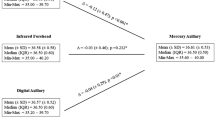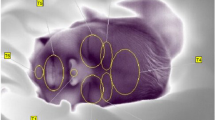Abstract
Objective:
To evaluate accuracy of mid-forehead (MFH) thermometry compared with digital axilla (DAT) temperatures in infants in newborn intensive care.
Study design:
A comparative study of MFH and DAT temperatures of newborn infants receiving tertiary-level intensive care. All admissions were considered and the following exclusion criteria applied: ‘in extremis’, hypoxic ischemic encephalopathy or non-English-speaking parents. Foot temperatures, infant and environmental variables were measured.
Result:
In all, 783 readings were obtained in 100 infants with a birth weight range 515 to 4885 g (mean 2152 g). The between-person correlation was 0.30 (P<0.001) and the within-person correlation was 0.52 (P<0.001). Bland–Altman plots showed wide 95% confidence intervals in the differences between MFH and DAT measurements (−0.87 to 1.16 °C). Differences were affected by infant variables measured. MFH more accurately predicted DAT measurements in smaller neonates and were less accurate in neonates requiring Bubble Continuous Positive Airway Pressure (CPAP).
Conclusion:
MFH thermometry is not able to replace DAT temperature recording in the newborn intensive care.
This is a preview of subscription content, access via your institution
Access options
Subscribe to this journal
Receive 12 print issues and online access
$259.00 per year
only $21.58 per issue
Buy this article
- Purchase on Springer Link
- Instant access to full article PDF
Prices may be subject to local taxes which are calculated during checkout


Similar content being viewed by others
References
Lyon AJ, Freer Y . Goals and options in keeping preterm babies warm. Arch Dis Child Fetal Neonatal Ed 2010; 96: F71–F74.
Rennie J, Kendall G . A Manual of Neonatal Intensive Care, 5th edn, CRC Press: Boca Raton, FL, USA, 2013.
De Curtis M, Calzolari F, Marciano A, Cardilli V, Barb G . Comparison between rectal and infrared skin temperature in the newborn. Arch Dis Child Fetal Neonatal Ed 2008; 93: F55–F57.
Smith J, Alcock G, Usher K . Temperature measurement in the preterm and term neonate: a review of the literature. Neonatal Netw 2013; 32: 16–25.
Duran R, Vatansever U, Acunas B, Sut N . Comparisons of temporal artery, mid forehead skin and axillary temperature recordings in preterm infants<1500 g of birthweght. J Paediatr Child Health 2009; 45: 444–447.
Uslu S, Ozdemir H, Bulbul A, Comert S, Bolat F, Can E et al. A comparison of different methods of temperature measurement in sick newborns. J Trop Paediatr 2011; 57: 418–423.
Bland JM, Altman DG . Measuring agreement in method comparison studies. Stat Methods Med Res. 1999; 8: 135–160.
Lund C, Browder N . The estimation of areas of burns. Gynaecol Obstet 1944; 79: 352–358.
Keeling EB . Thermoregulation and axillary temperature measurements in neonates: a review of the literature. Matern Child Nurs J 1992; 20: 124–140.
Kenner C, Brueggemeyer A, Gunderson L . Comprehensive Neonatal Nursing: A Physiological Perspective. WB Saunders Company: Philadelphia, PA, USA, 1993.
Jarvis M, Guy K, Konig K . Accuracy of infrared thermometers in very low birth weight infants and impact on newborn behavioural states. J Paediatr Child Health 2013; 49: 471–474.
Lyon AJ, Pikaar ME, Badger P, McIntosh N . Temperature control in very low birth weight infants during first five days of life. Arch Dis Child Fetal Neonatal Ed 1997; 76: F47–F50.
Author information
Authors and Affiliations
Corresponding author
Ethics declarations
Competing interests
The authors declare no conflict of interest.
Rights and permissions
About this article
Cite this article
Robertson-Smith, J., McCaffrey, F., Sayers, R. et al. A comparison of mid-forehead and axillary temperatures in newborn intensive care. J Perinatol 35, 120–122 (2015). https://doi.org/10.1038/jp.2014.148
Received:
Revised:
Accepted:
Published:
Issue Date:
DOI: https://doi.org/10.1038/jp.2014.148



